Taq-e Bostan Kermanshah
Wear your Iranian traditional clothing, this time we are going to participate in the …
Destination
Located right at the foot of the Zagros Mountains, Kermanshah has a lot to offer to its visitors. People in Kermanshah are Kurds who forge a large portion of ethnic groups in Iran. Despite so many earthquakes, Kermanshah has still preserved historical and archaeological sites for its enthusiasts.
Kermanshah is a great embodiment of prehistoric culture since excavations prove people’s settlements belonging to more than 10000 years ago.
Kermanshah was massively destroyed during the Iran-Iraq war and only a few of its sites are still preserved. Taq Bostan is a MUST- see in Kermanshah.

It is a craving depicting religious and royal ceremonies during the Sassanid Era. The 2000-year-old Bistoun World Heritage Site is another eye-appealing carvings that unfold a love story.
Takieh Mo’aven ol-Molk, Temple of Anahita, Ghoori Ghaleh Cave, and Shafei Mosque are other famous attractions of Kermanshah.
While visiting Kermanshah do not forget trying the very delicious sweet Nan Berenji which is made with Kermanshahi Oil as well. Dande Kebab and Tarkhine are also other foods you have to try there. Note that, being a baker and pastry chef is the main profession of locals and can be a suitable souvenir.
June to September are ideal months to visit Kermanshah. In case you cannot make it during summer, all seasons are good except for winter since it has cold and harsh winters.
![]() Gaziantep, turkey capital of Gaziantep Province
Gaziantep, turkey capital of Gaziantep Province
30-Day Iran Visa Delivered in 3 Days
The safe solution
The freedom to explore Iran
The fastest, most reliable & efficient
Show All
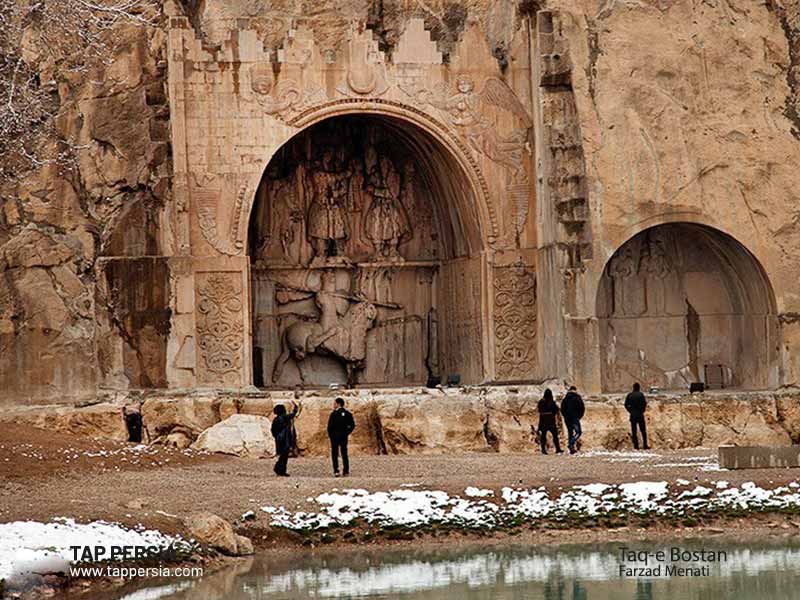
Taq-e Bostan, one of the most famous tourist places in Kermanshah, is a collection of lithographs and inscriptions of the Sassanid period. Thus, this collection has a lot of artistic and historical value, which includes two large and small arches and several inscriptions. What is carved on the stones of the two arches are the historical scenes of Khosrow Parviz’s coronation, Ardeshir II’s, Shahpour II’s, and III’s.
The surrounding mountains and springs in this place make it a fun promenade, as well. This monument is on Iran’s National Heritage List, also.
Behistun historical complex is located 30 km northeast of Kermanshah, southwest of Behistun, at the foot of a mountain with the same name. The sanctity of Mount Behistun, favorable weather conditions, and its location on important routes, including the Silk Road, were why many kings and rulers paid attention to this region. Therefore, you can see lots of monuments in the heart and slopes of this mountain.
This historical, cultural, and natural site has more than 150 historical monuments. 28 of them are nationally registered. The statue of Hercules, Behistun Bridge, Shah Abbasi Caravanserai, the engraved image of Mehrdad II, Farhad Tarash, the relief of Dariush and his inscription (which has been on the UNESCO World Heritage List since 2006), etc. are among the most important ones to visit. Because of the same reasons, this place is one of the most important archaeological sites in Iran. These hot spots belong to the Achaemenid period.
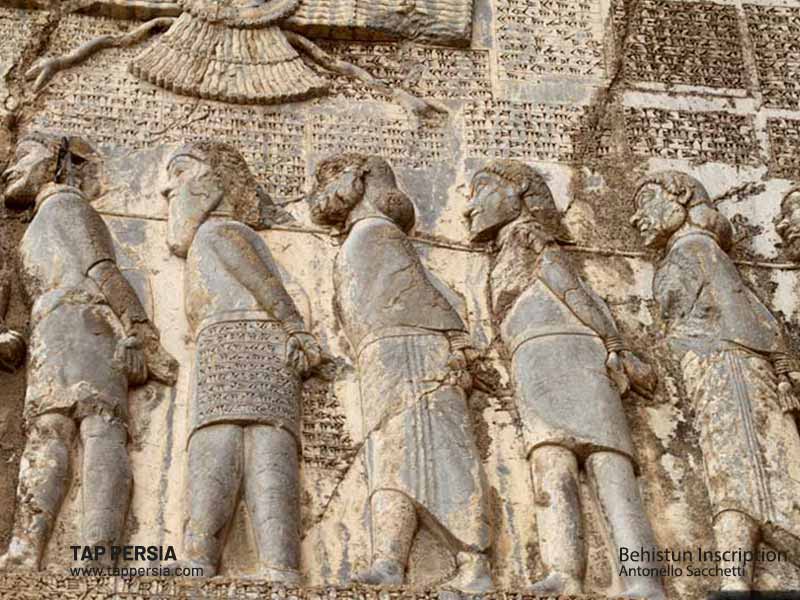
Hussein Khan Moin al-Ruaya 114 years ago established Tekiye Moaven Al Molk in the city of Kermanshah. Later, Hassan Khan Moin al-Mulk completed it. This complex consists of three main parts, Hosseinieh, Zeinabieh, and Abbasid sections. Its beautiful tiling is unique and eye-catching. The colors of the tiles of this building are natural and have given special beauty to this piece of art.
This place has been the host of the mourning of the people of Kermanshah. The Zeinabieh section was for women and had two doors. This made it possible for them to move around and participate in mourning ceremonies without encountering men.
The Hosseiniyah and Abbasid sections were also for men. These sections have unique tile works and paintings. You can find most of the amazing tile works in Husseinieh. Moreover, there are the museums of clothing and anthropology in the Abbasid section.
You can visit The statue of Hercules near the Behistun historical complex(Iran tourism places). This outstanding statue dates back to the Parthian and Seleucid eras. Above all, it is one of the few surviving relics from these historical periods. They discovered this statue during a civil operation in 1958. Hercules statue is one of the sights of Kermanshah that attracts many tourists every year.
Unfortunately, parts of this monument were damaged during the construction operation. The statue of Hercules is on the UNESCO list. It is on Iran’s National Heritage List as well.
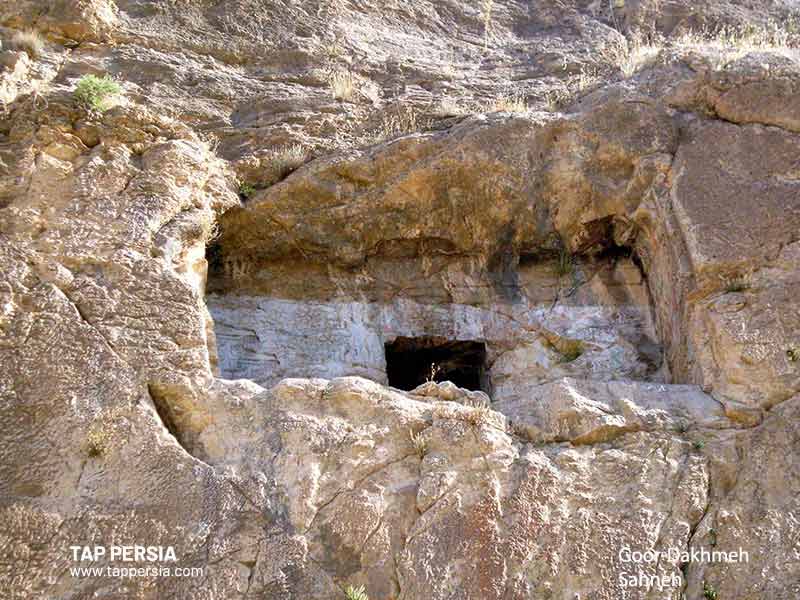
In the heart of Shogh Ali Mountain, in the north of Sahneh city, there is the Goor-Dakhmeh (roky catacombs) Sahneh, also known as Goor-Dakhmeh Darband. The locals refer to this tomb as the tomb of Kikavus, Farhad Tarash, or Shirin and Farhad. Some consider this catacomb to be one of the rarest two-story burial mounds of the Medes.
At an altitude of more than 50 meters above the river, at a site 14.5 meters long and 11 meters high they carved the mountain and built the crypt. Above the entrance of the tomb, there is a carved image of the rising sun. This historical monument is on Iran’s National Heritage List.
Kermanshah province has some of the most beautiful churches in Iran. “Assyrian Pentecostal“, “Prayer House” and “Sacred Heart of Christ” churches are among the most prominent churches in Kermanshah province. They built this Church in 1914 on a piece of land with an area of approximately 280 square meters. In fact, the construction of this church dates back to the reign of the Qajar dynasty in Iran.
30 km northeast of Kermanshah, you can find Behistun Caravanserai or Shah Abbasi Caravanserai, in front of Farhad Tarash (the famous relief of Dariush on the chest of Behistun Mountain), in the historical and cultural site of Behistun. This caravanserai in the style of four porches is 60.6 meters long and 14.55 meters wide. There are towers in the four corners of this building; The towers on the west side are circular and the towers on the east side are octagonal.
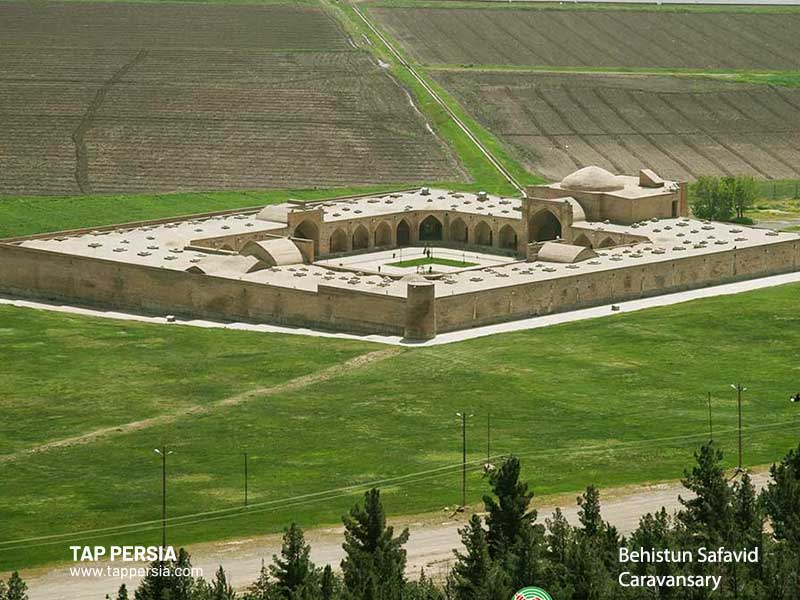 They built this caravanserai by the order of Shah Abbas I of the Safavid dynasty. According to the inscription left by Shah Suleiman the Safavid (15-5 AH) in this building, it seems that they completed the construction of this caravanserai during the reign of Shah Suleiman. Then, during the reign of Nasser al-Din Shah Qajar, they restored it again.
They built this caravanserai by the order of Shah Abbas I of the Safavid dynasty. According to the inscription left by Shah Suleiman the Safavid (15-5 AH) in this building, it seems that they completed the construction of this caravanserai during the reign of Shah Suleiman. Then, during the reign of Nasser al-Din Shah Qajar, they restored it again.
As its name implies, Haj Shahbaz Khan built Haj Shahbaz Khan bath in 1904. This Hammam (bath) is on Iran’s National Heritage List.
This historic bath, like many baths of the Qajar period, includes a changing room, and hot and cold water reservoirs, and so on. It also has all the architectural elements of traditional baths. The domes of this bath are beautifully decorated with Muqarnas. The changing room is also decorated with impressive murals.
Kermanshah Traditional Bazaar is one of the main parts of the city and one of the largest indoor bazaars in Iran. Additionally, it is one of the most attractive places in Kermanshah. This bazaar, due to the passage of the main streets of the city, is now divided into four parts and includes several sections. While visiting this stunning place, you can buy local clothes, souvenirs, and handicrafts of Kermanshah.
Nan Brenji Bazaar or Rice Bread Bazaar is one of the most interesting places in Kermanshah. It’s where you can prepare all kinds of delicious sweets, and souvenirs of Kermanshah. When you enter this bazaar, the pleasant smell of rice bread, which is made of rice flour, Kermanshahi oil, sugar, cardamom, and rose water, pleases you.
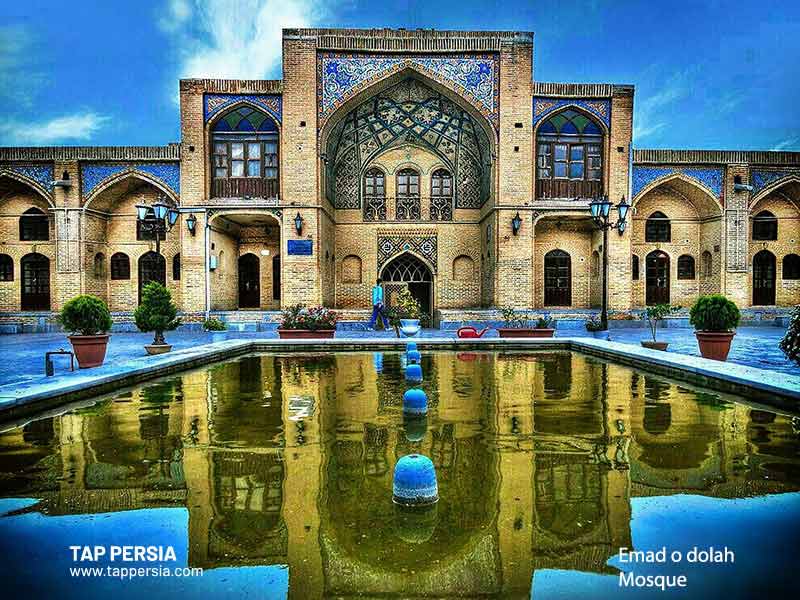
Today, the historical mosque of Emad Al-Dowleh is located in the heart of one of the most important sights of Kermanshah, the Traditional Bazaar. They build this structure during the Qajar era. The architecture of this historical mosque is a combination of the beauty of hand-made art and the spiritual and religious spirit. At first glance, it attracts the attention of any viewer in a way that they can’t help admiring it. The mosque has four Iwans and a minaret.
Most of the people of Kermanshah are Shia, but just like other cities in Iran, in this city, there are one or two synagogues, three or four churches, and a mosque that is for Sunnis. The mosque that belongs to the Sunnis is called Shafei Jameh Mosque and is one of the religious buildings and places of interest in Kermanshah. This mosque is full of beauty and is one of the most important architectural projects in ancient times. Over time this stunning structure has become one of the architectural and religious masterpieces of our country.
Saan Rostam burial ground is one of the sights of Kermanshah, 64 km south of the city, in the Jalalvand region. They dug a room inside a 5-meter-high rock pyramid. The burial chamber has an almost arched ceiling. Unlike the tombs of the Medes, this burial tomb is located at the bottom of a valley.
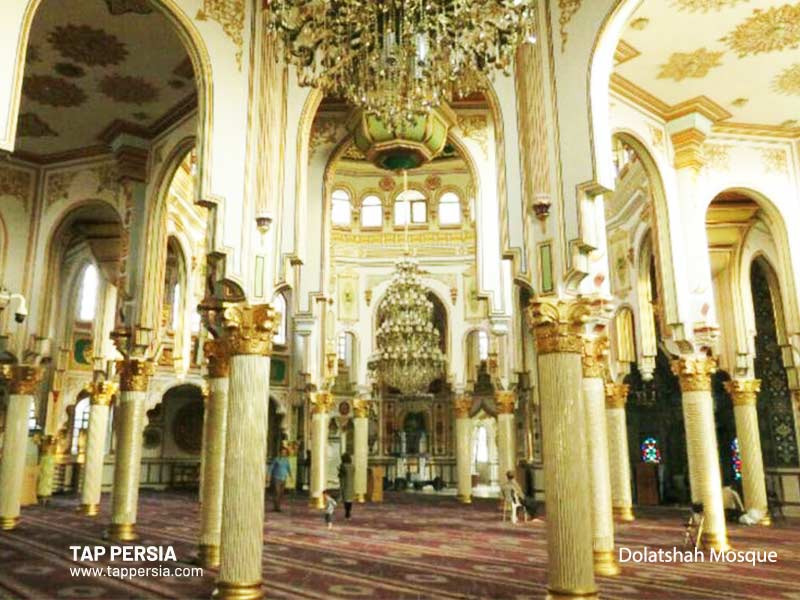 Dolatshah Mosque is one of the amazing historical mosques you should visit in Kermanshah. You can find it in Javanshir Square. The building of the mosque is one of the works of the Qajar period. This mosque is also known as Haj Abu Turab Al-e Agha Mosque.
Dolatshah Mosque is one of the amazing historical mosques you should visit in Kermanshah. You can find it in Javanshir Square. The building of the mosque is one of the works of the Qajar period. This mosque is also known as Haj Abu Turab Al-e Agha Mosque.
You can pay a visit to Khosrow Bridge, two kilometers southwest of Behistun on the Gamasiab River. In fact, the Khosrow Bridge is part of the Sassanid Behistun Dam. And is so similar to the Valerian Bridge of Shushtar, which also dates back to the Sassanid period.
Unfortunately, there are only some remains of the columns of the bridge. This bridge is on Iran’s Heritage List, as well.
The Zagros Paleolithic Museum is one of the sights of Kermanshah. And it is the first historical Paleolithic museum in the Middle East, which specializes in prehistoric fields. This museum is one of the best historical museums in the world. And you can find it in the Biglerbegi neighborhood, on Modares Street in the Kermanshah.
This museum includes a collection of stone tools and human bones from the Paleolithic period of Iran and other countries. The availability of Paleolithic areas in the Zagros and also the favorable conditions of this area for hunting have been some of the main reasons for the construction of this museum. The Zagros Paleolithic Museum contains the oldest evidence of human habitation in Iran, including stone tools and fossils of hunting animals.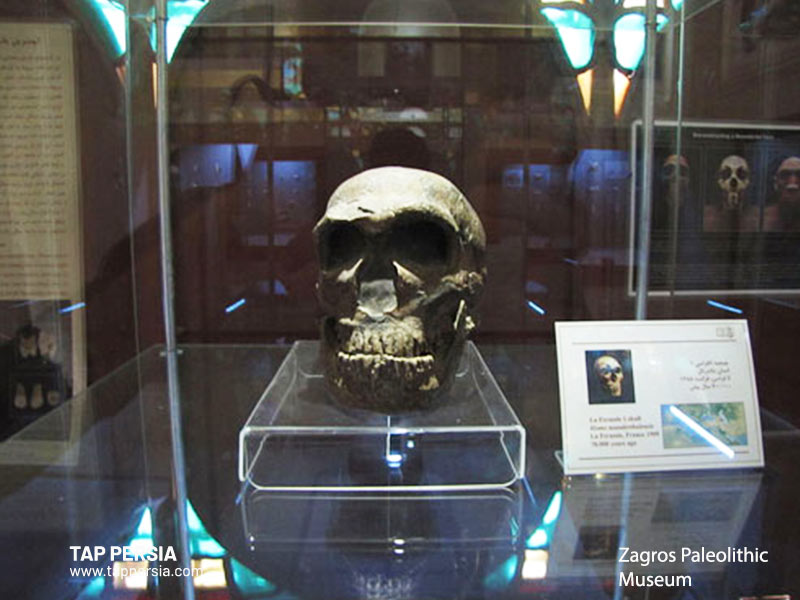
You can find Kermanshah Clothing and Jewelry Museum in Tekiye Moaven Al Molk in the southern part of the Abbasid section. This museum includes the local clothing of the people of Kermanshah. You can see the local clothing and jewelry of the men and women of Paveh, western parts of Gilan, Harsin, Qasr-e Shirin, and other cities of the province in this museum.
You can find the Anthropology Museum of Kermanshah in a hall on the southern side of the Abbasid section in Tekiye Moaven Al Molk. They established this museum on May 18, 1990. The museum has 29 showcases that include antiques, handicrafts, clothing, and items with cultural and social themes. In this museum, you can also see old agricultural tools, animal husbandry, hunting, weaving, writing tools, lighting tools, and examples of textiles.
You can visit Tekyeh Biglarbeygi in the old part of Kermanshah city in Feyzabad neighborhood. The building belongs to the Qajar period. This marvelous construction has a unique mirror work that makes it unique among the Tekyeh-s (a place people use to mourn) of Kermanshah. On the west side of its courtyard, there is a large mirror hall which they call Husseinieh. This hall is decorated with inscriptions that belong to the era of Muzaffar al-Din Shah.
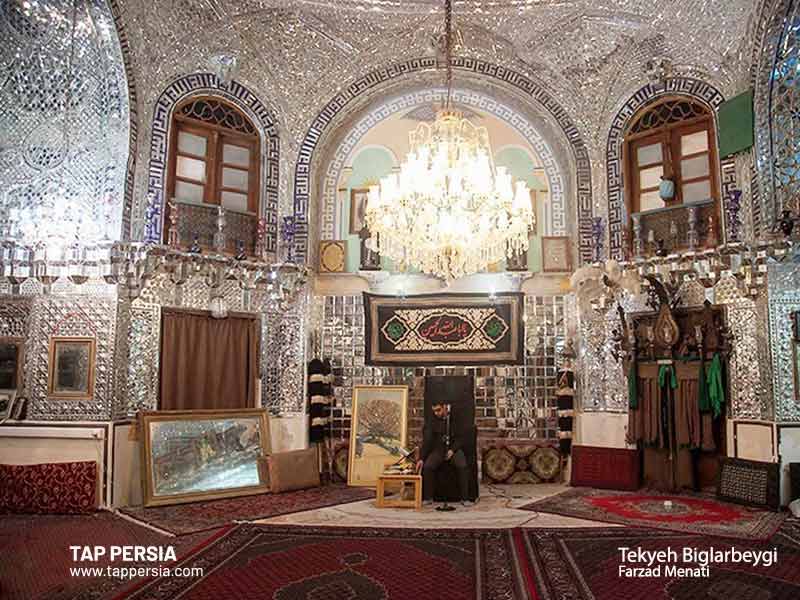 Nowadays, this place is a museum of calligraphy in Kermanshah. And it welcomes visitors and enthusiasts. Old documents from the Biglerby family are on display at the museum, as well.
Nowadays, this place is a museum of calligraphy in Kermanshah. And it welcomes visitors and enthusiasts. Old documents from the Biglerby family are on display at the museum, as well.
If you would like to visit The Stamp Museum you can find it at the post office of Shahid Ghandi in Kermanshah. The museum has two relatively large halls with several booths. In these halls, you can get to know Iranian stamps from the Qajar period until today. The subject of the stamps is mostly sports, literary, cultural, political, historical monuments, and important characters.
In addition to the stamps, there are documents, coins, old inscriptions, an envelope that is nearly a century old and has not been opened and sealed yet, old stamp-making tools, ordinary mailboxes, and so on. As one of the sights of Kermanshah, this museum hosts many visitors and tourists annually.
Taq-e Bostan Stone Museum is one of the sights of Kermanshah in the same historical site. There are about 45 stone artifacts related to the Islamic and Sassanid periods in this museum. The museum also contains 14 column capitals from the Sassanid era that have been prepared for the construction of the palace. But they have never been used. Other interesting items in this museum are the half-body statue of Khosro Parviz Sassanid, a coffin, and jars related to the Sassanid period. Moreover, there are columns in the museum, that they transferred some of them from the Anahita Temple in Kangavar city.
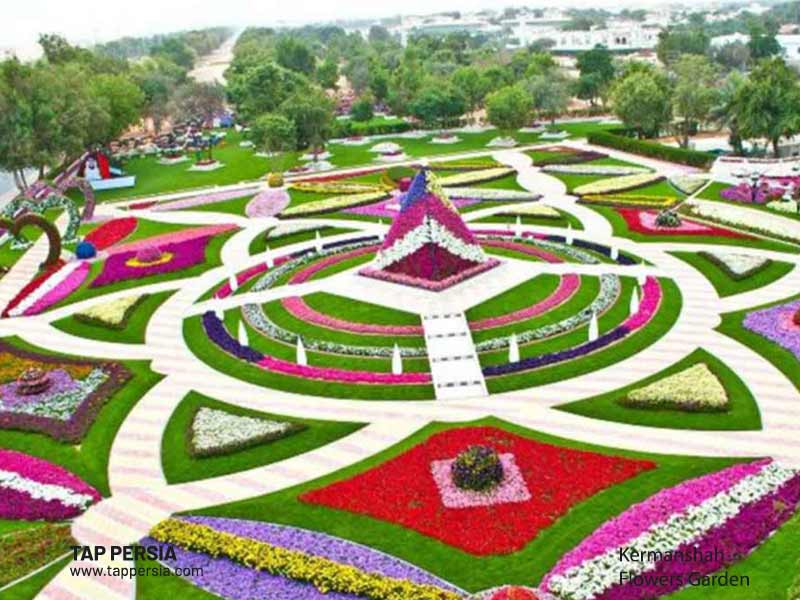
Kermanshah flower garden is one of the newly established sights of this province. This paradise and beautiful garden represents a colorful world of Iranian and foreign flowers to its guests. It is very unique.
Kermanshah flower garden is in the second place after the Iranian flower garden in Isfahan. This attraction has an area of 6,400 square meters. They have used all the methods of gardening in the world in designing and implementing the Kermanshah flower garden, as well as the Iranian garden approach.
Sadaf Bird Garden is one of the tourist attractions of Kermanshah, next to Arghavan Park. This complex with an area of two hectares was put into operation in 2011. And there are 30,000 birds, in other words, 130 species in this garden. Therefore, it is one of the largest bird gardens in the Middle East. Most of the birds in the garden are imported and purchased from South America and East Asia.
Wooden bridges, paths among the reeds, waterfalls, rivers, and pools have added to the beauty and charm of this complex. The garden also has a boarding house and a specialized bird hospital.
Kermanshah Museum of Natural History is one of the museums and tourist places in Kermanshah, in the Faculty of Agriculture of Razi University. You can find the university on Shohada Street.
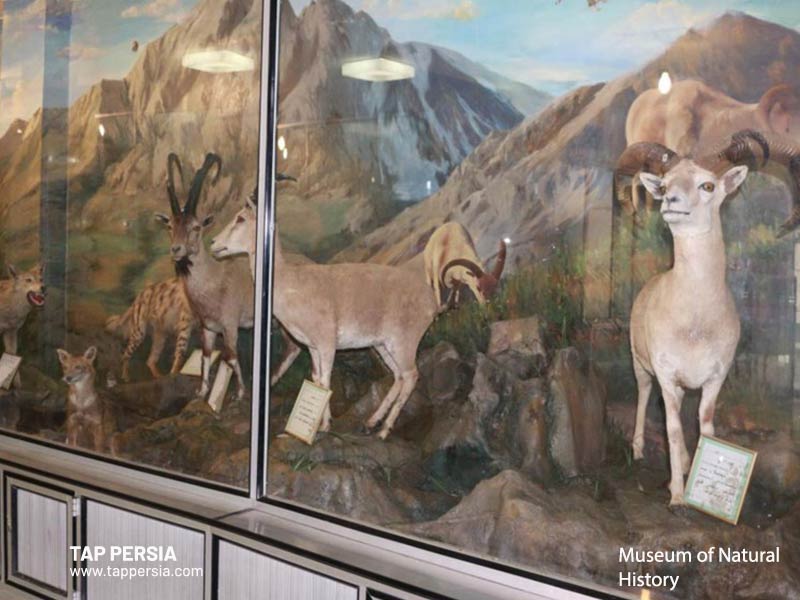 The museum exhibits many specimens of plant and animal species. This specialized museum has two halls and eight booths. In these booths, there are many samples of plant and animal species such as taxidermy birds, mammals, fossils, as well as animal and human embryos on display.
The museum exhibits many specimens of plant and animal species. This specialized museum has two halls and eight booths. In these booths, there are many samples of plant and animal species such as taxidermy birds, mammals, fossils, as well as animal and human embryos on display.
You can visit Kermanshah Calligraphy Museum in Tekye Biglerbegi. In this museum, you can get to know historical documents and manuscripts of calligraphy. Above all the building is such a huge beauty you can enjoy visiting.
Sefid Kuh (Mount White) is one of the sights of Kermanshah, 10 km south of the city. Its highest peak is 2805 meters. The ridge of Sefid Kuh is the natural border between Dorudfaraman Rural District and Sar Firoozabad Mahidasht. The water of the northern slope of this mountain flows into the river “Qarah Su” and the water of its southern slope flows into the river “Death“.
Parau or Paraw is the name of a cave in Parau Mountain. You can visit this cave 12 km northeast of Kermanshah, between Taq-e Bostan Mountain and Mount Behistun. It’s nice to know, Parau in the local language means full of water.
They discovered Parau Cave 40 years ago. Then, It was the largest vertical cave in the world. On that account, they have been calling it “The Everest of the Caves of the World“. Parau Cave is the second national natural monument of Kermanshah that is on Iran’s National Heritage List.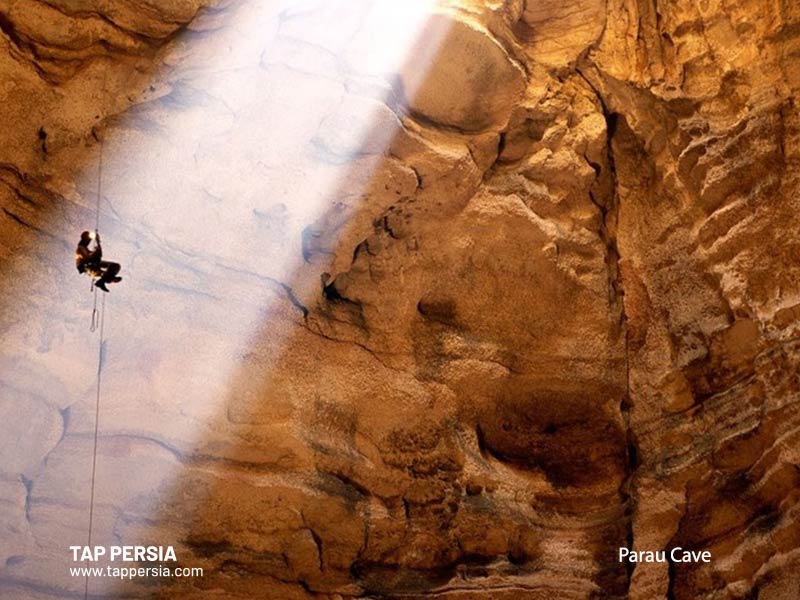
One of the unique features of Parau Cave is its entrance. Because its entrance is at an altitude of three thousand meters above sea level. This height is the highest level among all the caves in the world.
Sarab Niloofar (Lotus Mirage) Lake is a small lake 20 km northwest of Kermanshah. This lake is full of lotus flowers, especially in hot seasons. The lotus buds and leaves emerge from the water and cover a large part of it.
There are lots of tourist welfare facilities around this place. Sarab Niloufar is the fifty-fifth is on Iran National Heritage List, as well.
To visit Hashilan Wetland you need to go about 30 km northwest of Kermanshah. The General Department of Environmental Protection of Kermanshah has declared this wetland as a no-hunting and no-shooting area. In this wetland, there are about 110 small and large islands with an area of approximately 100 square meters to about one hectare. Some of them go underwater in winter and on rainy days, due to the increase in the water flow of the wetland.
The name of the wetland is Kurdish. It consists of two parts: “Hashi” meaning snake and “Lan” meaning house. Therefore, the name Heshilan means nest of snakes; Because there are many snakes in this lagoon, especially Natrix and Dice snakes.
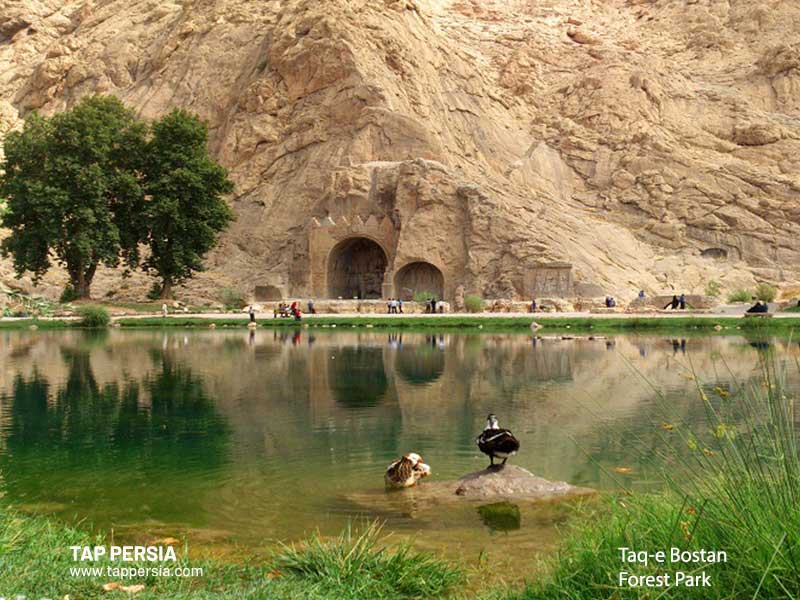 Next to one of the most important places of interest in Kermanshah, the historical complex of Taq-e-Bostan, there is The Taq-e-Bostan Forest Park. On the north side of Kermanshah, remember the slopes of Mount Parau? You can find this park there. And kill many birds with one stone.
Next to one of the most important places of interest in Kermanshah, the historical complex of Taq-e-Bostan, there is The Taq-e-Bostan Forest Park. On the north side of Kermanshah, remember the slopes of Mount Parau? You can find this park there. And kill many birds with one stone.
Natural elements such as mountains, springs, green space, artificial lakes, and the reliefs from the Sassanid period, all have created an attractive and spectacular environment in this area.
At an altitude of 1600 meters above sea level, you can visit Do-Ashkaft Cave. This site consists of two caves next to each other. These caves are the oldest remains of human habitation in the city of Kermanshah. According to archeological studies, this cave was inhabited by humans (probably Neanderthals) during the Middle Paleolithic (120,000 to 40,000 years ago). If you have a good opportunity for mountaineering, it is better not to be satisfied with the view of the city from the mountain park and sit in the cave of D- Ashkaft to enjoy the view.
Varvasi Cave is one of the sights of Kermanshah, 11 km northeast of the city. You can find it at the foot of Massi Mountain, in a valley known as Tang Konasht. According to research, this stone shelter has been a good place for the temporary settlement of hunters. The animal remains that they discovered in the cave also confirm this assumption.
Gharasoo is a river that flows in the plain of Kermanshah and passes through the city. This river originates from Sarab Ravansar lake in the northwest of Kermanshah. Then, after passing through the city in the Faramaan region, it flows into Gamasiab river.
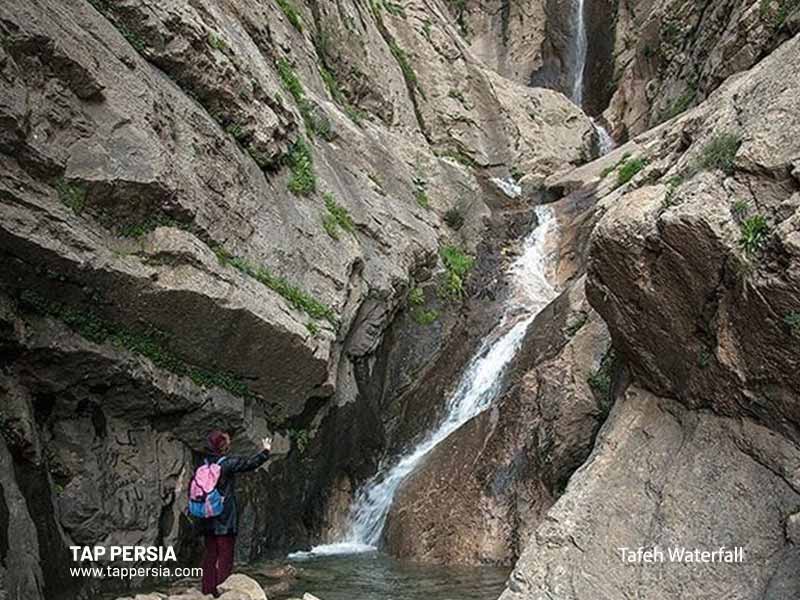
Tafeh waterfall is one of the natural attractions and sights of Kermanshah, in Behistun protected area. After 15 years of drought, Tafeh Waterfall has re-emerged in recent years. Boiling water from the springs of this waterfall passes through a ten-step path and irrigates the surrounding trees along the way.
Mar-Div cave is one of the sights of Kermanshah, 15 km from Kermanshah-Behistun road, near Chalabeh village, on the left side of Parau primary route. Probably because the cave is kind of scary, the locals call it Mar Div.
You can find Asangaran Cave in the northwest of the Parau Mountains, in a valley called Tang Kooh. There are four wells with different depths of 16, 8, 6, and 36 meters. The third and fourth wells of this cave are connected to each other. if you continue to the end of the cave you can see a pool-like space.
Kher or Markher cave is one of the sights of Kermanshah at the foot of Behistun mountain, northeast of Varvasi cave. In the excavations of the cave, they discovered stone and bone tools, animal remains, charcoal, pottery, and other samples. The oldest of them belongs to the Middle Paleolithic period, which includes thick stone blades, etc.
Wear your Iranian traditional clothing, this time we are going to participate in the …
“Once I visited a country, I enjoyed lots of historical and cultural heritages, the …